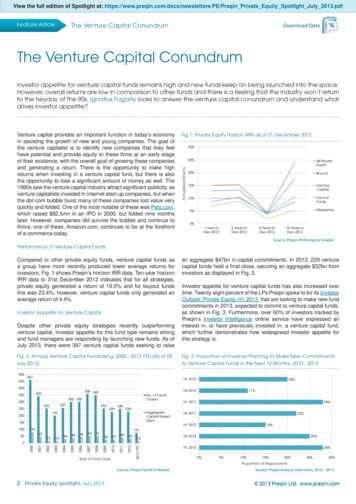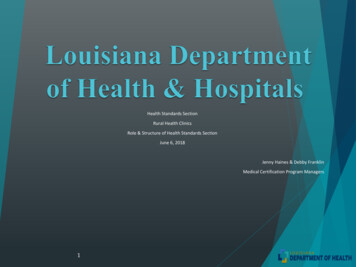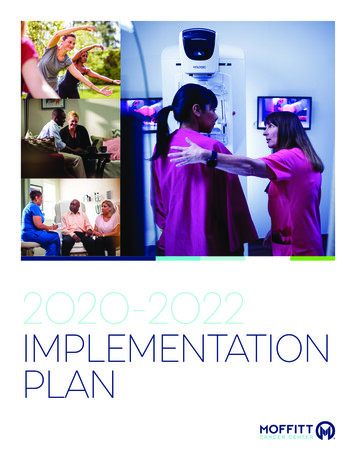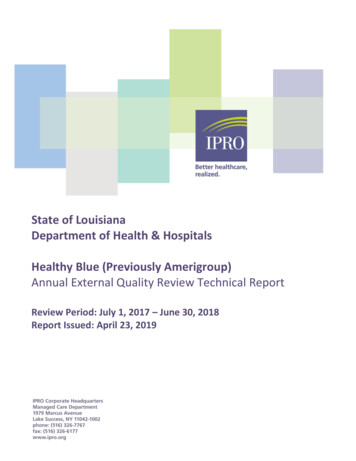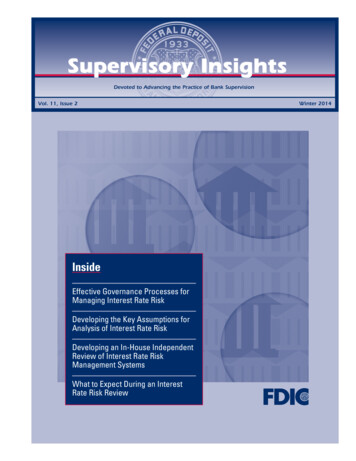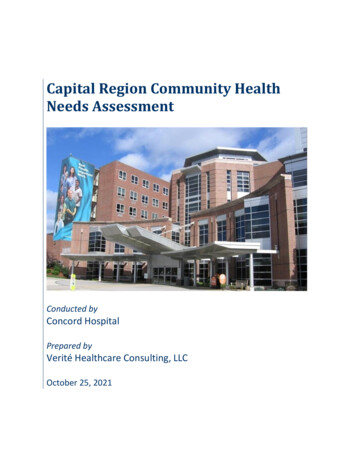
Transcription
Capital Region Community HealthNeeds AssessmentConducted byConcord HospitalPrepared byVerité Healthcare Consulting, LLCOctober 25, 2021
TABLE OF CONTENTSTABLE OF CONTENTS. 2EXECUTIVE SUMMARY . 4Introduction . 4Community Assessed . 6Prioritized Significant Community Health Needs . 7Access to Health Services. 7Aging Population . 8Chronic Diseases . 8COVID-19 Pandemic and Effects . 9Mental Health . 9Navigating the Healthcare System . 10Nutrition, Physical Activity, and Obesity . 10Substance Misuse Disorder . 11Social Determinants (Basic Needs & Transportation) . 11DATA AND ANALYSIS . 12Community Definition . 12Secondary Data Summary . 15Demographics . 15Socioeconomic Indicators. 15Other Local Health Status and Access Indicators. 16Food Deserts . 17Medically Underserved Areas and Populations . 17Health Professional Shortage Areas . 18CDC COVID-19 Prevalence and Mortality Findings . 18Findings of Other CHNAs . 19Primary Data Summary . 20Key Stakeholder Interviews. 20Community Survey . 24Concord Hospital Staff Survey . 30OTHER FACILITIES AND RESOURCES IN THE COMMUNITY . 32Hospitals . 32Federally Qualified Health Centers . 33Other Community Resources. 34Capital RegionCommunity Health Needs Assessment2
APPENDIX A – OBJECTIVES AND METHODOLOGY . 35Regulatory Requirements . 35Methodology. 35Collaborating Organizations . 36Data Sources . 37Consultant Qualifications . 37Information Gaps . 38Input on Previous CHNA . 38APPENDIX B – SECONDARY DATA ASSESSMENT . 39Demographics . 40Socioeconomic indicators . 48People in Poverty. 48Unemployment . 52Health Insurance Status . 53Housing Affordability . 55Crime Rates . 57Dignity Health Community Need Index . 58Centers for Disease Control and Prevention Social Vulnerability Index (SVI) . 60Other Health Status and Access Indicators . 64County Health Rankings. 64Community Health Status Indicators . 68COVID-19 Incidence and Mortality . 70Mortality Rates . 71Communicable Diseases . 74Maternal and Child Health . 75Behavioral Risk Factor Surveillance System . 77Youth Risk Behavior Survey . 81PLACES Project . 83Food Deserts . 86Medically Underserved Areas and Populations . 87Health Professional Shortage Areas . 88Findings of Other Assessments . 91CDC COVID-19 Prevalence and Mortality Findings . 91New Hampshire State Health Improvement Plan, 2013-2020 . 93Capital Area Public Health Network Community Health Improvement Plan, 2015-2020 . 93LRGHealthcare CHNA for Lakes Region General Hospital and Franklin Regional Hospital, 2020 . 94APPENDIX C – IMPACT EVALUATION . 95Capital RegionCommunity Health Needs Assessment3
EXECUTIVE SUMMARYEXECUTIVE SUMMARYIntroductionThis Capital Region Community Health Needs Assessment (CHNA) was conducted by ConcordHospital (“the hospital”) to identify significant community health needs and to informdevelopment of an Implementation Strategy to address current needs.Concord Hospital, founded in 1884, is a 295-licensed-bed facility located in Concord, NewHampshire. Concord Hospital is a charitable organization, which exists to meet the health needsof individuals within the communities it serves.It is the established policy of Concord Hospital to provide services on the sole basis of themedical necessity of such services as determined by the medical staff without reference to race,color, ethnicity, national origin, sexual orientation, marital status, religion, age, gender,disability, or inability to pay for such services.The Concord Hospital campus is 114 acres of which 29 are in conservation easement. Thebuildings on campus include the Payson Center for Cancer Care, Granite Ledges of Concord,Encompass Health Rehabilitation Hospital of Concord, Memorial Medical Office Building,Pillsbury Medical Office Building, Concord Hospital Family Health Center - Concord, ConcordOrthopaedics Professional Association, Granite VNA Hospice House, and The Learning Center.Off-campus locations include Concord Hospital Medical Offices North, Concord HospitalMedical Offices East, Concord Hospital Medical Offices at Horseshoe Pond, Family HealthCenter-Hillsborough, and 49 South Main Street. Concord Hospital is a regional acute care,health system with five centers of excellence: Center for Cardiac Care;Center for Urologic Care;Payson Center for Cancer Care;The Orthopaedic Institute; andWomen's Health Services.Concord Hospital has 295 licensed beds and 238 staffed beds. In 2020, there were 11,336inpatient admissions and 28,631 emergency room visits.Concord Hospital recently acquired Lakes Region General Hospital and Franklin RegionalHospital after the bankruptcy of LRGHealthcare. As of May 1, 2021, these hospital facilities areknown as Concord Hospital Laconia and Concord Hospital Franklin. These hospitals serve theLakes Region, an area immediately north of the Capital Region. LRGHealthcare CHNA forLakes Region General Hospital and Franklin Regional Hospital was completed in 2020;references will be made to the findings from the LRGH CHNA in select sections of thisdocument.Capital RegionCommunity Health Needs Assessment4
EXECUTIVE SUMMARYThis CHNA is conducted using widely accepted methodologies to identify the significant healthneeds of a specific community. The assessment also is conducted to comply with federal andstate laws and regulations.Capital RegionCommunity Health Needs Assessment5
EXECUTIVE SUMMARYCommunity AssessedFor purposes of this CHNA, Concord Hospital’s community is defined as the “Capital Region”of New Hampshire. The Capital Region can also be defined by thirty towns. These towns areAllenstown, Andover, Barnstead, Boscawen, Bow, Bradford, Canterbury, Center Barnstead,Chichester, Concord, Deering, Dunbarton, Epsom, Henniker, Hillsborough, Hooksett,Hopkinton, Loudon, Northwood, Pembroke, Penacook, Pittsfield, Salisbury, Suncook, Sutton,Warner, Washington, Weare, Webster, and Windsor.The Capital Region also can be defined by twenty-five ZIP Codes. These ZIP Codes are 03301,03303, 03275, 03244, 03304, 03307, 03263, 03234, 03229, 03281, 03242, 03225, 03278, 03258,03261, 03224, 03268, 03106, 03218, 03221, 03046, 03216, and 03280.Exhibit 1 presents a map displaying the ZIP Codes and towns that comprise Concord’scommunity of the Capital Region.Exhibit 1: The Concord Community of the Capital RegionSource: Caliper Maptitude, 2021.In 2020, these ZIP Codes accounted for over 65 percent of inpatient discharges and nearly 80percent of emergency room visits.The total population of the Concord Community in 2019 was approximately 150,000.Capital RegionCommunity Health Needs Assessment6
EXECUTIVE SUMMARYPrioritized Significant Community Health NeedsNine significant community health needs were identified through this assessment. Thesesignificant health needs are as follows, in alphabetical order: Access to Health ServicesAging PopulationChronic DiseasesCOVID-19 Pandemic and EffectsMental HealthNavigating the Healthcare SystemSubstance Misuse DisorderNutrition, Physical Activity, and ObesitySocial Determinants (Basic Needs & Transportation)These significant health needs in the community served by Concord Hospital were identifiedbased on analyses of secondary data, primary data received through key stakeholder interviewsand surveys, and assessments produced by public health departments. Categories of communityhealth needs are aligned with objectives of Healthy People 2030, ten-year national healthobjectives of the U.S. Department of Health and Human Services, and the 2020 CommunityBenefits Report Guide published by the Office of the New Hampshire Attorney General.Details of prioritized significant needs are summarized below.Access to Health ServicesAccess to health services is the timely use of health care. Elements of timely use include entry tothe health care system through insurance, geographic accessibility, and culturally competentproviders. Financial barriers and health care staffing shortages may impede timely access tohealth care. Five primary care, four dental health, and three mental health Health ProfessionalShortage Areas (HPSAs) are identified within Merrimack County (Exhibit 55, 56, 57).The low-income populations of rural areas of Belknap, Grafton, and Merrimack countieswere identified as primary care Medically Underserved Populations (Exhibit 54).Access challenges to health care services were identified by many interviewees assignificant issues within the community.“Access to providers” represented 21.7 percent of responses in the community survey asthe most-important health-related issue for their family (Exhibit 7).Financial barriers were selected by 14.3 percent of community members as reasons healthservices could not be accessed (8.9 percent for “Deductible or copayment is tooexpensive” and 5.4 percent for “Do not have insurance (cannot afford it)”) (Exhibit 12).“Affordable health insurance, cost of care and prescription drugs” was identified as asignificant need in the 2020 LRGHealthcare CHNA for Lakes Region General Hospitaland Franklin Regional Hospital.Capital RegionCommunity Health Needs Assessment7
EXECUTIVE SUMMARYAging PopulationThe population is aging and “aging in place.” This growth will increase needed support forhealthcare, housing, transportation, and nutrition assistance. The Merrimack County population 65 years and older is projected to grow nearly twentypercent from 2019 to 2024, much more rapidly than the projected total change inpopulation (Exhibit 19).The CDC found that eight of ten COVID-19 deaths have been in adults aged 65 or older.Interview participants indicated that assistance is needed to maintain health andindependence for some community members, including seniors.“Services and supports for older adults including health care” was identified as asignificant need in the 2020 LRGHealthcare CHNA for Lakes Region General Hospitaland Franklin Regional Hospital.Chronic DiseasesChronic diseases in the community include arthritis, asthma, cancers, cardiovascular disease,diabetes, hypertension, kidney disease, and pulmonary issues. Contributing lifestyle factorsmight also include poor nutrition, alcohol consumption, and physical inactivity. Four of the top five causes of mortality in Merrimack County are related to chronicdiseases and the rates are higher than the rates of the United States and/or NewHampshire (Exhibit 42).“Chronic diseases” was selected by 7.9 percent of responses in the staff survey as themost important health-related issue for patients served by Concord Hospital (Exhibit 14).The CDC found that chronic diseases may increase risk of severe illness and outcomesrelated to COVID-19 infection.The NH Department of Health and Human Services State Health Improvement Plan(SHIP) identified four of ten priority areas as chronic diseases (obesity/diabetes, heartdisease and stroke, cancer prevention, and asthma).Capital RegionCommunity Health Needs Assessment8
EXECUTIVE SUMMARYCOVID-19 Pandemic and EffectsSince emerging in 2019, COVID-19 has become a health emergency for the Capital Region, thenation, and the world. The virus has wrought severe illness and death, and the pandemic hascontributed to unmet basic needs from the resulting economic crises, chronic disease severity,increased mental health needs, and decreased access to health services. The CDC provides information, data, and guidance regarding the COVID-19 pandemic.To date, the CDC has found that underlying medical conditions may contribute to diseaseseverity, older adults are disproportionately at risk of severe illness and death, men aremore likely to die from COVID-19, and members of racial and ethnic minority groups areat increased risk of contracting COVID-19.All interview participants discussed the immediate and profound impact of COVID-19 onthe community. Participants indicated that COVID-19-related illness and deaths haveimpacted all communities and has especially affected seniors and low-income residents.The economic impact of the pandemic has increased basic needs instability, includinghousing. Anxiety and isolation have increased substance use disorders and isolation hasimpacted access to behavioral health treatment.Mental HealthMental health status is poor for many residents because of the impact of the COVID-19pandemic, day-to-day pressures, substance misuse, and psychiatric disorders. The supply ofmental health providers is insufficient to meet the demand for mental health services. The mortality rate from intentional self-harm in Merrimack County is more than 50percent higher than the U.S. rate (Exhibit 42).Three mental health HPSAs are identified with Merrimack County (Exhibit 57).“Mental health” represented 13.2 percent of responses in the community survey as themost important health-related issue for the community (8.2 percent for “Mental health,adults” and 5.0 percent for “Mental health, children and youth) (Exhibit 8). “Mentalhealth care or counseling” represented 10.5 percent of responses as a needed service thatcould not be accessed (7.8 percent for care or counseling for adults and 2.7 percent forcare or counseling for children) (Exhibit 11).“Mental health” represented 22.7 percent of responses in the staff survey as the mostimportant health-related issue for patients served by Concord Hospital (13.1 percent for“Mental health, adults” and 9.6 percent for “Mental health, children”) (Exhibit 12).Interview participants indicated that significant and urgent demand for behavioral healthservices exceeded the current capacity of mental health providers.The Community Health Improvement Plan (“CHIP”) produced by the Capital AreaPublic Health Network Community identified “Access to comprehensive behavioralhealth services” as one of eight priority areas.“Availability of mental health services” was identified as a significant need in the 2020LRGHealthcare CHNA for Lakes Region General Hospital and Franklin RegionalHospital.Capital RegionCommunity Health Needs Assessment9
EXECUTIVE SUMMARYNavigating the Healthcare SystemMany changes in the health care provider environment are leading to anxiety by residents.Additional changes, such as increased utilization of telehealth services during the COVID-19pandemic, are leading to uncertainty among residents in how to access healthcare services. The preventable hospitalization rate for Merrimack County is higher than peer counties(Exhibit 40). Merrimack County is in the bottom half of New Hampshire counties forpreventable hospital stays (Exhibit 38).A higher percentage of Capital Region residents had a disability than residents of NewHampshire and the United States (Exhibit 23A).Interview participants indicated that navigating the health care environment andcoordinating services provided by different providers is challenging for some communitymembers. Navigation may be especially difficult for community members with multipleneeds, limited health literacy, language isolation, limited-resources, and/or otherchallenges.“Navigating the healthcare system” was selected as 13.7 percent of responses in the staffsurvey as the service most difficult for patients to access in the community (Exhibit 15).Nutrition, Physical Activity, and ObesityDiet and body weight are related to health status, and healthy diets can help individuals reducerisks for many health conditions. Regular physical activity can improve the health and quality oflife for individuals of all ages, regardless of the presence of a chronic disease or disability. The obesity rate for Merrimack County is higher than peer counties (Exhibit 40).The physical inactivity rate for Merrimack County is higher than peer counties (Exhibit40).The region and New Hampshire compare unfavorably to the United States forOverweight (BMI 25.0-29.9) status (Exhibit 48A).The CDC found that obesity may increase risk of severe illness and outcomes related toCOVID-19 infection.The NH Department of Health and Human Services State Health Improvement Planidentified “Obesity/diabetes” as one of its ten priority areas.The Community Health Improvement Plan (“CHIP”) produced by the Capital AreaPublic Health Network Community identified “Obesity” as one of eight priority areas.Capital RegionCommunity Health Needs Assessment10
EXECUTIVE SUMMARYSubstance Misuse DisorderSubstance misuse in the community includes alcohol, tobacco, and multiple illegal substances.Substance misuse is cumulative and significant to numerous costly social, physical, mental, andpublic health problems. The excessive drinking rate for Merrimack County is higher than the United Statesaverage (Exhibit 39A).Merrimack County and New Hampshire compare unfavorably to national averages fortobacco use during pregnancy (Exhibit 46).The drug poisoning mortality rates for Merrimack County were higher than the U.S. ratesfor 2014 through 2018 and increased over the time period (Exhibit 44).Interview participants indicated that Substance Misuse Disorder, including alcoholdependency, has significant impact on the community and may have increased during theCOVID-19 pandemic.The CDC found that smoking may increase risk of severe illness and outcomes related toCOVID-19 infection.The NH Department of Health and Human Services State Health Improvement Planidentified “Misuse of alcohol and drugs” as one of its ten priority areas.The Community Health Improvement Plan (“CHIP”) produced by the Capital AreaPublic Health Network Community identified “Misuse of alcohol and drugs” as one ofeight priority areas.“Alcohol and drug use prevention, treatment and recovery” was identified as a significantneed in the 2020 LRGHealthcare CHNA for Lakes Region General Hospital and FranklinRegional Hospital.Social Determinants (Basic Needs & Transportation)Social determinants of health are social, economic, physical, and other conditions that affect awide range of health outcomes. Quality of life is affected by access to resources, includinghousing, education, public safety, and healthy food. Exposure to crime and violence cannegatively impact health through direct physical injury, mental distress, and lasting trauma. In several towns in the Capital Region, more than 30 percent of the households arehousing burdened (Exhibit 21).In several areas of the Capital Region, rates of murder/non-negligent manslaughter andrape were more than 50 percent higher than United States averages in 2019 (Exhibit 31).Interview participants indicated that accessing basic needs is challenging for somecommunity members because of economic factors and social determinants of health,including transportation and affordable housing.The Community Health Improvement Plan (“CHIP”) produced by the Capital AreaPublic Health Network Community identified “Economic wellbeing” as one of eightpriority areas.“Economic determinants of health” was identified as a significant need in the 2020LRGHealthcare CHNA for Lakes Region General Hospital and Franklin RegionalHospital.Capital RegionCommunity Health Needs Assessment11
DATA AND ANALYSISDATA AND ANALYSISCommunity DefinitionThis section identifies the community that was assessed by Concord Hospital. The community isdefined as the “Capital Region” of New Hampshire. The community is defined by twenty-ninetowns and twenty-five ZIP Codes. Exhibit 2 lists specific towns and ZIP Codes included in thecommunity definition.Exhibit 2: Towns and ZIP Codes within the Concord BradfordCanterburyCenter nerWashingtonWeareWebsterWindsorZIP 00328103303*03244** ZIP Code includes more than one townCapital RegionCommunity Health Needs Assessment12
DATA AND ANALYSISExhibit 3 presents a map displaying the ZIP Codes and towns that comprise Concord’scommunity of the Capital Region.Exhibit 3: ZIP Codes within the Concord CommunitySource: Caliper Maptitude, 2021.The hospital is located in Concord, NH (ZIP Code 03301), Merrimack County.As illustrated in Exhibit 4, the community ZIP Codes accounted for over 65 percent of inpatientdischarges and nearly 80 percent of emergency room visits.Exhibit 4: Concord Hospital Discharges and Emergency Room Visits, 2019LocationCommunityOther ent2020EmergencyRoom 8,631Source: Analysis of Concord Hospital’s utilization data, 2020.Capital RegionCommunity Health Needs 0%
DATA AND ANALYSISAs summarized in Exhibit 5, the total population of the Concord Hospital community in 2019was approximately 152,000 persons. Over 88 percent of the community resided in MerrimackCounty, New Hampshire.Exhibit 5: Population by Town and ZIP Code, 2019TownAllenstownZIP 3303*Bow03304Bradford03221Canterbury03224Center Barnstead al RegionSource: Census via mySidewalk.* ZIP Code includes more than one townCapital RegionCommunity Health Needs 3102,9461,1999,03115,8497,652151,851
DATA AND ANALYSISSecondary Data SummaryThe following section summarizes principal observations from the secondary data analysis. SeeAppendix B for more detailed information.DemographicsDemographic characteristics and trends directly influence community health needs. The totalpopulation in the Capital Region is expected to grow 2.0 percent from 2019 to 2024(ap
Medical Offices East, Concord Hospital Medical Offices at Horseshoe Pond, Family Health Center-Hillsborough, and 49 South Main Street. Concord Hospital is a regional acute care, health system with five centers of excellence: Center for Cardiac Care; Center for Urologic Care; Payson Center for Cancer Care;
